What Landmark Legal Precedents Are Set by the Latest Supreme Court Rulings?
The recent term of the Supreme Court has produced a series of landmark legal precedents that will reshape American jurisprudence for generations. These decisions reflect the Court’s evolving interpretation of constitutional principles and statutory frameworks, establishing new legal standards that will guide lower courts, legislators, and executive agencies. The significance of these rulings cannot be overstated, as they touch upon fundamental aspects of our constitutional structure, including the separation of powers, individual liberties, and the scope of federal authority. Understanding these precedents requires careful analysis of the Court’s reasoning, the historical context of the issues presented, and the potential implications for future cases.
The Court’s recent decisions demonstrate a willingness to reconsider long-established doctrines when they appear inconsistent with the original understanding of constitutional text or when they have proven unworkable in practice. This approach to judicial interpretation reflects a commitment to legal principles rather than mere policy preferences, ensuring that our constitutional system remains faithful to its foundational premises while adapting to contemporary challenges. The landmark precedents established in these rulings will influence not only the specific areas of law they address but also the broader methodology of constitutional and statutory interpretation employed by courts throughout the federal judiciary.
These decisions come at a time of significant political and social division, with the Court facing intense scrutiny from various quarters. Yet the justices have remained focused on their constitutional duty to say what the law is, rather than what it should be. This judicial restraint, coupled with rigorous legal analysis, has produced precedents that clarify previously ambiguous areas of law while respecting the proper role of the judiciary in our system of separated powers.
The Demise of Chevron Deference
The Court’s decision to overturn the Chevron doctrine represents one of the most consequential shifts in administrative law in decades. For nearly forty years, courts deferred to federal agencies’ reasonable interpretations of ambiguous statutes they administered. This doctrine, established in Chevron v. Natural Resources Defense Council (1984), fundamentally altered the relationship between the judiciary and the administrative state, granting significant interpretive authority to executive agencies rather than courts.
The Court’s rejection of this framework in Loper Bright Enterprises v. Raimondo marks a significant restoration of judicial authority over statutory interpretation. Chief Justice Roberts, writing for the majority, declared the Chevron doctrine “fundamentally misguided,” emphasizing that determining the meaning of statutes is a quintessentially judicial function that cannot be abdicated to administrative agencies. This ruling recognizes that Article III vests the judicial power exclusively in the courts, not in executive branch officials who may be influenced by political considerations rather than legal principles.
The practical implications of this decision are far-reaching. Federal agencies will no longer receive automatic deference when interpreting ambiguous statutory provisions, requiring them to provide more persuasive legal justifications for their regulatory actions. Courts will now exercise independent judgment when reviewing agency interpretations, potentially leading to more rigorous judicial scrutiny of administrative rulemaking. This shift restores the traditional separation of powers, ensuring that judges, not bureaucrats, have the final say on questions of statutory meaning.
Presidential Immunity and Executive Power
The Court’s ruling in Trump v. United States established a landmark precedent regarding presidential immunity that will shape executive power jurisprudence for generations. For the first time, the Court explicitly recognized that presidents enjoy absolute immunity from prosecution for official acts taken within their constitutional authority. This decision reinforces the unique constitutional position of the presidency and acknowledges the dangers of subjecting presidential decision-making to potential criminal liability.
The Court drew an important distinction between official acts, which receive absolute immunity, and unofficial acts, which do not. This nuanced approach balances the need to protect the presidency as an institution with the principle that no person is above the law. By establishing this framework, the Court has provided crucial guidance for lower courts evaluating claims of presidential immunity in current and future cases, creating a precedent that transcends any particular administration.
The immunity decision reflects a profound understanding of the separation of powers and the unique constitutional role of the presidency. As the Court recognized, the threat of criminal prosecution for official acts could severely impair a president’s ability to make difficult decisions and faithfully execute the laws. This precedent ensures that presidents can fulfill their constitutional duties without fear of politically motivated prosecutions while preserving accountability for truly private conduct.
Redefining Administrative Authority
Beyond overturning the Chevron doctrine, the Court has established several other landmark precedents that collectively redefine the scope of administrative authority. These decisions reflect a broader reconsideration of the administrative state’s constitutional foundations and the proper limits of executive power in our system of separated powers.
The Court’s ruling significantly curtails the ability of federal agencies to make major policy decisions without clear congressional authorization. This “major questions doctrine” requires Congress to speak clearly when authorizing agencies to decide issues of vast economic or political significance. By strengthening this doctrine, the Court has established a precedent that prevents administrative agencies from claiming broad regulatory authority based on vague or ambiguous statutory provisions.
This precedent reinforces democratic accountability by ensuring that major policy decisions are made by elected representatives in Congress rather than unelected bureaucrats. It also protects individual liberty by preventing agencies from expanding their authority beyond what Congress has explicitly authorized. The long-term impact of this ruling will likely be a more restrained administrative state that respects constitutional boundaries and legislative supremacy in policymaking.
Free Speech in the Digital Age
The Court’s decisions addressing social media regulation establish crucial precedents for free speech in the digital era. In cases challenging state laws that sought to restrict content moderation by social media platforms, the Court recognized that these platforms possess First Amendment rights to select, edit, and remove content on their services. This precedent affirms that digital platforms, like traditional publishers, enjoy constitutional protection for their editorial discretion.
Justice Kagan, writing for the majority, rejected attempts to treat digital platforms differently from other speech intermediaries, emphasizing that “this is just the newest form of speech in our society and all the old rules about editors and publishers and content selection apply.” This precedent establishes that government cannot compel private platforms to carry specific content or viewpoints, even in the name of promoting viewpoint diversity or preventing alleged bias.
The Court’s approach demonstrates a commitment to applying established First Amendment principles to new technologies rather than creating special constitutional rules for digital media. This precedent will guide lower courts in evaluating future attempts to regulate online speech, ensuring that constitutional protections remain robust in the digital environment while allowing platforms to establish their own content policies.
Civil Rights and Equal Protection
The Court’s recent term included several decisions establishing important precedents in the realm of civil rights law. These rulings clarify the scope of federal civil rights statutes and the constitutional principles that underlie them, providing guidance for future litigation in this critical area.
In Health and Hospital Corporation of Marion County v. Talevski, the Court affirmed that individuals can sue state entities for violations of rights established under federal spending legislation through Section 1983. This 7-2 decision, which surprised many observers, preserves a crucial enforcement mechanism for various civil rights laws. Justice Jackson’s majority opinion emphasized that the text of Section 1983 applies to “laws” without limitation, rejecting arguments that would have severely restricted private enforcement of federal rights.
This precedent has significant implications for nursing home residents, people with disabilities, and individuals protected by anti-discrimination provisions in federal funding statutes. By preserving private rights of action under Section 1983, the Court ensured that vulnerable populations retain an important tool for vindicating their federally protected rights when state actors violate them.
Constitutional Interpretation Methodology
Throughout its recent decisions, the Court has further developed and refined its approach to constitutional interpretation, establishing methodological precedents that will influence judicial decision-making across a wide range of issues. These precedents reflect a commitment to originalism and textualism while acknowledging the role of historical practice and precedent in constitutional adjudication.
The Court’s emphasis on historical analysis in constitutional cases demonstrates a continued commitment to understanding constitutional provisions according to their original public meaning. This approach grounds constitutional interpretation in objective historical evidence rather than evolving social values or policy preferences, providing a more stable and predictable foundation for constitutional law.
At the same time, the Court has shown a willingness to reconsider precedents that lack firm grounding in constitutional text, structure, or history. This methodological approach ensures that constitutional interpretation remains faithful to the document itself rather than judicial innovations that may have strayed from its original meaning. The precedential value of this interpretive methodology extends beyond any particular case, influencing how lower courts will approach constitutional questions in the future.
Federalism and State Authority
Several of the Court’s recent decisions establish important precedents regarding federalism and the proper balance of authority between federal and state governments. These rulings clarify the constitutional boundaries that limit federal power and preserve state sovereignty in our federal system.
The Court has reinforced the principle that federal agencies cannot exceed the authority delegated to them by Congress, particularly when their actions would intrude upon traditional areas of state regulation. This precedent protects state autonomy against federal administrative overreach, ensuring that significant policy decisions affecting the federal-state balance receive democratic consideration in Congress rather than bureaucratic determination.
These federalism precedents reflect the Court’s recognition that our constitutional structure divides power not only among the three branches of the federal government but also between the federal government and the states. By enforcing these structural limitations, the Court has established precedents that preserve the diverse policy approaches that federalism enables while ensuring that federal authority remains within its proper constitutional bounds.
Environmental Law and Regulatory Authority
The Court’s decisions addressing environmental regulation establish significant precedents regarding the scope of federal authority to address pollution and natural resource management. These rulings clarify the statutory and constitutional limits on agency power in this important area of law.
The overturning of Chevron will have particularly profound implications for environmental regulation, as many environmental statutes contain broad or ambiguous provisions that agencies have interpreted expansively. Under the new precedent, courts will independently interpret these provisions rather than deferring to agency constructions, potentially leading to more restrained readings of federal environmental authority.
This shift may require Congress to speak more clearly when delegating authority to environmental agencies, ensuring democratic accountability for major regulatory decisions. The precedent established in these cases reflects a commitment to the rule of law and separation of powers in environmental regulation, without prejudging the substantive policy outcomes that should result.
Criminal Procedure and Due Process
The Court has also established important precedents in the realm of criminal procedure, clarifying constitutional protections for defendants and the proper scope of prosecutorial authority. These decisions will guide lower courts in ensuring that criminal proceedings comport with due process while allowing legitimate law enforcement interests to be pursued.
The Court’s ruling on the prosecution of January 6 defendants established an important precedent regarding the proper interpretation of federal criminal statutes. By rejecting an expansive reading of the relevant provision, the Court reinforced the principle that criminal laws must be construed narrowly, with ambiguities resolved in favor of the defendant. This precedent protects individual liberty by ensuring that prosecutors cannot stretch criminal statutes beyond their fair meaning.
These criminal procedure precedents reflect the Court’s commitment to constitutional protections in the criminal justice system while recognizing the government’s legitimate interest in prosecuting actual violations of the law. By establishing clear guidelines for the interpretation and application of criminal statutes, the Court has created precedents that will promote both justice and predictability in criminal cases.
Healthcare and the Affordable Care Act
The Court’s decisions addressing healthcare issues establish precedents that will shape the legal framework governing this vital sector of the economy. These rulings clarify the rights of patients, the obligations of providers, and the scope of federal authority to regulate healthcare markets.
The precedent established in Talevski regarding private enforcement of rights under federal spending legislation has particular significance for healthcare programs that rely on federal funding. By preserving the ability of individuals to sue state entities for violations of federally established rights, the Court ensured that beneficiaries of programs like Medicaid retain an important enforcement mechanism when states fail to comply with federal requirements.
These healthcare precedents reflect the Court’s careful consideration of both individual rights and structural constitutional principles in this complex area of law. By establishing clear legal standards, the Court has provided guidance that will inform future litigation and policymaking regarding healthcare regulation and access.
Religious Liberty Jurisprudence
The Court has continued to develop important precedents regarding religious liberty and the proper interpretation of the First Amendment’s religion clauses. These decisions clarify the constitutional protections for religious exercise and the limitations on government authority to burden religious practice.
The Court’s religious liberty jurisprudence has increasingly emphasized that the Free Exercise Clause requires religious adherents and organizations to receive equal treatment from the government, not special disabilities based on their religious character. This precedent ensures that religious individuals and entities can participate in public programs and civic life on equal terms with their secular counterparts.
These religious liberty precedents reflect the Court’s understanding that religious freedom represents a fundamental constitutional value that deserves robust protection. By establishing clear standards for evaluating government actions that burden religious exercise, the Court has created precedents that will guide lower courts in preserving this essential liberty while respecting other important governmental interests.
Second Amendment Rights
The Court’s recent decisions addressing gun rights build upon the landmark precedents established in District of Columbia v. Heller and McDonald v. City of Chicago, further clarifying the scope of the Second Amendment right to keep and bear arms. These rulings establish important standards for evaluating firearms regulations at various levels of government.
The Court has reinforced that the Second Amendment protects an individual right to possess firearms for lawful purposes, not merely a collective right connected to militia service. This precedent ensures that courts will scrutinize gun regulations to ensure they comport with the constitutional text and history rather than deferring uncritically to legislative judgments.
These Second Amendment precedents reflect the Court’s commitment to taking all constitutional rights seriously, including those that may be politically controversial. By establishing clear standards for evaluating firearms regulations, the Court has created precedents that will guide lower courts in distinguishing between permissible public safety measures and unconstitutional infringements on Second Amendment rights.
Election Law and Democratic Processes
The Court’s decisions addressing election law establish important precedents regarding the constitutional framework governing democratic processes. These rulings clarify the proper roles of state legislatures, state courts, and federal courts in establishing and interpreting election rules.
The Court has emphasized that the Constitution assigns primary responsibility for regulating elections to state legislatures, subject to congressional oversight within the limits of federal authority. This precedent reinforces the decentralized nature of our electoral system while ensuring that state election procedures remain subject to constitutional constraints.
These election law precedents reflect the Court’s careful consideration of both democratic principles and constitutional text. By establishing clear standards for resolving election disputes, the Court has created precedents that will guide lower courts in ensuring that elections remain both free and fair.
Implications for Future Litigation
The landmark precedents established in the Court’s recent decisions will shape litigation strategies and judicial decision-making for years to come. Attorneys must carefully consider how these precedents apply to their cases and adapt their arguments accordingly.
The overturning of Chevron will fundamentally alter administrative law litigation, requiring lawyers to develop more robust textual and structural arguments rather than relying on agency deference. Cases challenging agency actions will focus more intensely on statutory interpretation, with courts exercising independent judgment about the meaning of regulatory statutes.
Similarly, the Court’s clarification of presidential immunity will influence how cases involving executive officials are litigated, requiring careful analysis of whether challenged actions constitute official or unofficial conduct. These precedents provide a roadmap for future litigation while leaving some questions open for further development in subsequent cases.
The Court’s Institutional Role
The Court’s recent decisions reflect a particular understanding of the judiciary’s proper role in our constitutional system. By establishing precedents that enforce structural constitutional principles and textual limitations on government power, the Court has demonstrated a commitment to legal principle over policy preference.
Critics have characterized some of these decisions as a “power grab” by the judiciary, particularly the overturning of Chevron deference. However, this criticism misunderstands the nature of judicial power. The Court has not claimed new authority for itself but rather reclaimed the traditional judicial function of independently interpreting the law, a responsibility that had been partially abdicated under the Chevron regime.
The precedents established in these cases reflect a vision of the judiciary as a check on the other branches, ensuring that they act within their constitutional boundaries rather than deferring to their policy judgments. This approach strengthens the rule of law by ensuring that government action comports with legal constraints, not merely political preferences.
Conclusion: The Lasting Impact of Recent Precedents
The landmark legal precedents established in the Court’s recent decisions will reshape American law for decades to come. By clarifying constitutional principles, statutory interpretation methodologies, and the proper roles of various governmental actors, these precedents provide guidance that will influence countless future cases across diverse areas of law.
The Court’s willingness to reconsider established doctrines when they lack firm legal foundation demonstrates a commitment to constitutional principle over mere stability. While stare decisis remains an important consideration, the Court has recognized that it must ultimately be guided by the law itself rather than its own prior mistakes. This approach ensures that our legal system remains faithful to its foundational texts and principles.
As these precedents are applied and developed in future cases, their full implications will become increasingly clear. What remains certain is that the Court’s recent term has produced decisions of profound significance that will influence American law and governance for generations. These landmark precedents reflect the Court’s essential role in our constitutional system: saying what the law is, not what it should be, and ensuring that all government action comports with legal constraints.
Citations:
- Significant Supreme Court Cases 2022-2023 Term
- Supreme Court Blockbuster Decisions Implications
- 2024-2025 Supreme Court Term Preview
- High Stakes Recent Supreme Court Rulings
- Supreme Court Weakens Federal Agencies Precedent
- Supreme Court Upends Foundational Legal Principle
- Supreme Court Strikes Down Chevron Ruling
- Landmark Supreme Court Decisions Overview
- Peoples Guide to 2024-2025 Supreme Court
- Harvard Law Faculty on Supreme Court Decisions
- Supreme Court Major Civil Rights Decision
- Chevron Ruling Impacts Big Business Wins
- 2024 Federal Supreme Court Cases
- Constitutional Annotations on Article 3
- Educational Resources on Supreme Court Landmarks
- Landmark Supreme Court Cases Collection
- Brennan Center Landmark Supreme Court Cases
- American Bar Criminal Justice Supreme Court
- Major SCOTUS Cases Threats to Rule of Law
- SCOTUS Blog on Supreme Court Updates
- Supreme Court Slip Opinions Archive
- Supreme Court Decisions Impact on Lives
- Official Supreme Court Website
- Oyez Supreme Court Case Database
- Major End-Term Supreme Court Cases
- ACLU Supreme Court Case Listings
- 2024 Supreme Court Slip Opinions
- Supreme Court Cases on Abortion and Trump
- Notable Supreme Court Cases 2023-2024
- 2023-2024 Supreme Court Term Roundup
- AP News Hub on U.S. Supreme Court
- 2024 Significant State Constitutional Cases
- Previewing 2024 Supreme Court Term Attacks
- Indiana Supreme Court Case 2020 Ruling
- Law Firm SEO Keyword Research Guide
- SEO for Attorneys Keyword Research Tips
- SEO for Lawyers Keyword Strategies
- SEO Basics for Lawyers Keyword Research
- Buying Competitive Keywords Not Trademark Infringement
- Sage Journal on Legal Keyword Advertising
- General Law Keywords for SEO and PPC
- Competitor Keyword Bidding Legal Insights
- LSU Law on Keyword Advertising Issues
- Supreme Court Clarifies False Advertising Standing
- Harvard Law Review on Supreme Court Cases
- Landmark Civil Rights Cases by Supreme Court
- Chevron Doctrine Struck Down by Supreme Court
- Scope of Precedent in Supreme Court Rulings
- Civil Rights Supreme Court Decisions Overview
- ProPublica on Chevron Deference and Pending Cases
- Supreme Court Threats to Rights and Democracy
- SCOTUS Ruling Strips Power from Federal Agencies
- American Bar on Landmark Supreme Court Cases
- Congress on Decisions Overruled by Supreme Court
- Wikipedia List of Landmark U.S. Court Decisions
- Justia Federal Supreme Court Cases Archive
- Justia Supreme Court Case Database
- Bloomberg Law Report on Supreme Court Impact
- The Nation on Supreme Court Rulings Impact
- No Confusion from Keywords Federal Ruling
- Are Law Firms Allowed Google Advertising
- Argentina Supreme Court on Keyword Advertising
- BYU Law Review on Keyword Advertising
- No Infringement in Buying Competitor Marks
- Language Log on Legal Precedent Semantics
- Bidding on Competitors Keywords Court Ruling
- Stanford on Legal Reasoning and Precedent
- Supreme Court Constitutional Role Overview




















